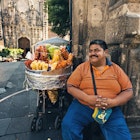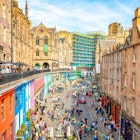
Jul 3, 2025 • 8 min read
From swimming near whale sharks to spotting colorful fish over a reef, here are the world's best places to snorkel.

Jul 3, 2025 • 8 min read
From swimming near whale sharks to spotting colorful fish over a reef, here are the world's best places to snorkel.

Jul 3, 2025 • 6 min read
Mexico City street food fuses tradition and flavor, keeping locals well-fed. From chilaquiles to elotes, here's what to try and how to find it.

Jul 3, 2025 • 3 min read
Whether you're seeking fun festivals, fall apple-picking or live college football, you'll find it all in Atlanta.

Jul 3, 2025 • 9 min read
Edinburgh is the crown jewel of the British Isles, blending the medieval, the regal and the outright fantastic. Here are the top things to do.

Jul 3, 2025 • 6 min read
Pick your season carefully, prepare for a living lesson in Black history and never say “Hotlanta”: here’s all you need to know before visiting Atlanta.

Jul 2, 2025 • 5 min read
While Turin is the home of the Fiat, you'll want to go car-free and explore by public transportation or your own two feet.

Jul 2, 2025 • 7 min read
Whatever you enjoy, Atlanta has you covered. From lively public markets to compelling museums, these are the best things to do in Atlanta.

Jul 2, 2025 • 7 min read
Here are the books we’re reading on the road this summer, and the travel-worthy destinations they're set in.

Jul 2, 2025 • 7 min read
Discover the best of Santa Barbara from sunny beaches to wine tastings and vibrant nightlife with this comprehensive guide.

Jul 2, 2025 • 8 min read
New Orleans' great food and distinct flavors have a reputation internationally. Here's where you should eat in NOLA right now.

Jul 2, 2025 • 6 min read
In advance of the Seine reopening to the public for swimming, here are other fabulous spots for beating the summer heat of Paris with a refreshing dip.

Jul 2, 2025 • 6 min read
Discover Mughal forts, vibrant markets, artisan crafts, delicious food and hidden historical gems.

Jul 2, 2025 • 7 min read
Here’s a restaurant-by-restaurant guide to San Juan’s sizzling culinary scene.

Jul 2, 2025 • 5 min read
We asked a trio of our most knowledgeable New Zealand–connected correspondents for recommendations about where they vacation in their country.

Jul 2, 2025 • 9 min read
Experience the best of England with these top things to do, from city museums to seaside escapes.

Jul 2, 2025 • 7 min read
Piraeus is the largest Mediterranean port in terms of passenger traffic and commercial activity, and most of Athens' visitors simply consider it a transit…

Jul 1, 2025 • 6 min read
From catching local buses, hiring a car or hopping by plane between islands, here's what you need to know to get around in the Canary Islands.

Jul 1, 2025 • 6 min read
From hiking the Carian Trail to marveling at ancient ruins to savoring flavorful cuisine, Carian Türkiye is sure to bring you a special experience.

Jul 1, 2025 • 8 min read
When it comes to two Polish titans battling for first place, how can you possibly choose just one to spend your time in? Let our writers help you out.

Jul 1, 2025 • 5 min read
For tourists in Japan, taxis are comfortable and convenient. Here's how to hail, ride and pay.

Jul 1, 2025 • 5 min read
As one of Italy’s great unsung destinations, Turin is a good year-round destination. Here's when to make the most of it.

Jul 1, 2025 • 10 min read
With its historic churches, gorgeous art, dreamy beaches and urban tableaux, Sicily brims with free experiences. These are 12 of the best ones.